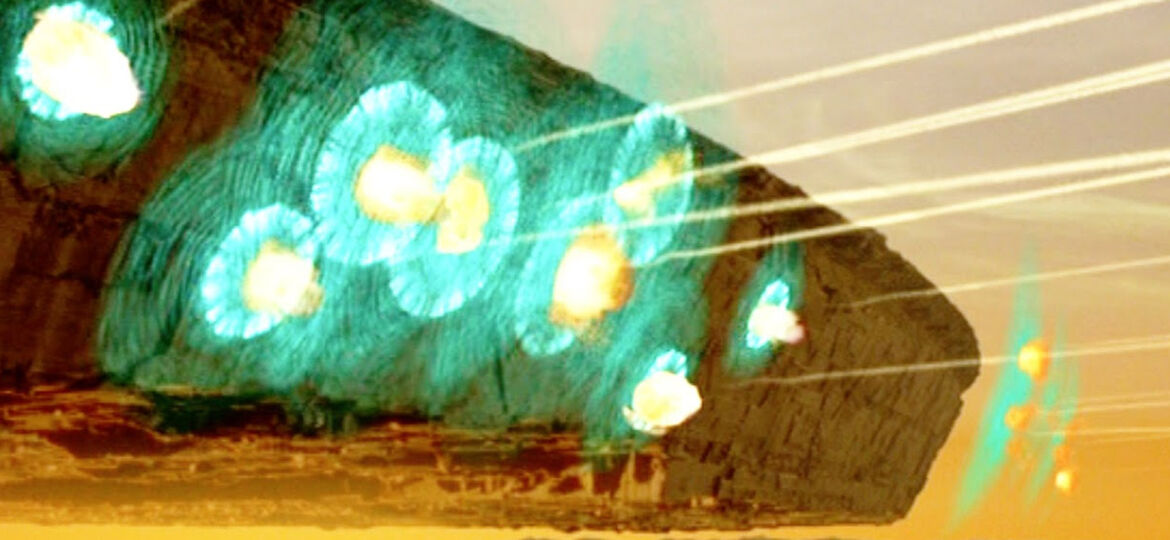
WHY THIS MATTERS IN BRIEF
Plenty of companies are developing new laser and direct energy weapons systems but none have ever managed to create one, that might be about to change.
Deflector shields are the stuff of science fiction – whether it’s the rippling green shields that saw off Will Smith’s F/A-18’s in Independence Day or the Star Trek shields that batted off the Klingons advances. But until now they remained just that – science fiction.
Now, scientists at BAE Systems believe a new type of directed energy laser and lens system that manipulates the atmosphere could make such devices a reality, and in as little as fifty years from now.
Known as the Laser Developed Atmospheric Lens (LDAL) the concept works by simulating naturally occurring phenomena that temporarily alters small parts of the Earth’s atmosphere to create lens like structures that magnify or alter the path of electromagnetic waves – including radio signals and light.
According to BAE, a lens generated in this way could be used as a type of deflector shield to protect aircraft, land vehicles, troops, and ships from assault by high powered laser weapons.
LDAL’s prime purpose, however, is to enable better electromagnetic communications by re-creating a number of naturally occurring effects, such as the reflective atmospheric effects found in the ionosphere and the kind that are behind some of the more quirky atmospheric phenomenon such as desert mirages. LDAL mimics many of these effects by using high powered lasers to heat parts of the atmosphere which helps to create highly reflective areas, such as the ionosphere, or areas where light can be bent at will, such as is the case with desert mirages.
Using these techniques LDAL would allow operators to send high frequency signals further than ever before, or produce localized, Fresnel lens like refractive areas that bend electromagnetic waves to a specific point on Earth – even when the direction was at a completely different angle to the original waves.
The system takes advantage of the “Kerr Effect,” an optical phenomenon that occurs when intense light is transmitted through media such as glass or, in this case, gases in the atmosphere, that alters the media’s refractive index, to temporarily ionize a small patch of atmosphere in a way that allows the air to simulate mirrors, glass lenses, and structures like Fresnel zone plates that diffract light.
“Working with some of the best scientific minds in the UK, we’re able to incorporate emerging and disruptive technologies and evolve the landscape of potential military technologies in ways that, five or ten years ago, many would never have dreamed possible,” said Professor Nick Colosimo, BAE Systems’ Futurist and Technologist.
While other companies, such as General Atomics, Lockheed Martin and Northrup Grumman are also developing laser and direct energy weapons systems this is the first time a company has thought about using a laser system to create a deflector shield that protects assets from laser weapons, and while it’s merely a concept at this stage the science is sound. However, there is also a flip side to this new concept as well, and the theory goes that if you can bend light and extend the range of sensor systems then it also becomes a superb global spying tool… Ah, science – you’ve got t love it!

















[…] assembler technology – truly sci-fi stuff, and that’s bearing in mind I also talk about deflector shields and rat to rat, human to human, and human to robot telepathy – that they used to grow a […]
[…] for storage, and it’s another example of science fiction turning into science fact – along with deflector shields, laser weapons, tractor beams and […]
Do you have any plans for the release of the new Star Wars movie? What about a working laser plasma lightsaber. 🙂
Always got to think one step ahead to seize the opportunities, mitigate the threats, and spend time being thoughtful about the implications.
WOW
! and we only have to wait 50 years for it !
Completely different proposition. These effects using PPLs already demonstrated in the lab to an extent. Challenge is scaling up and the engineering.
That has a certain ring to it … The Empire Strikes Back !
Nicely in time for the new Star Wars film!
[…] while ago I talked about BAE’s attempts to create what amounted to the world’s first force field that could deflect lasers like in the sci-fi movies, and then a few years later the US military […]